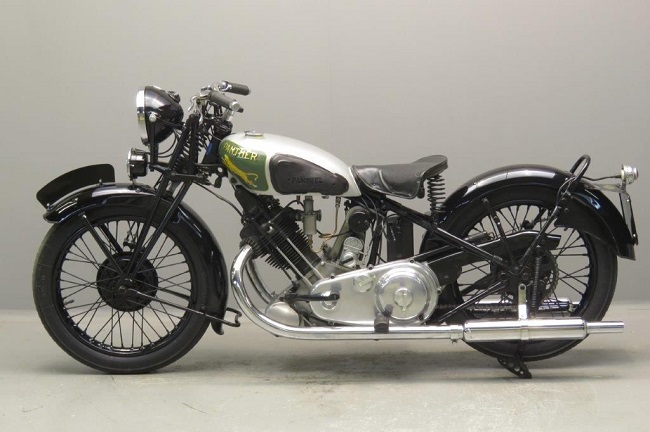Low and sleek, the Panther Model 100 was an iconic British motorcycle in the early and mid-1900s. It was ultimately one of the most successful bikes, with a production run of over 30 years. During that time, it evolved considerably but never lost its classic style and form.
The Birth of the Panther Model 100
The Panther name dates back well before the debut of the 100, although it later became synonymous with this particular model. Engineers at Phelon & Moore decided to take the 598cc engine from the Model 85 Redwing and install it in a new bike – the Model 100. The bike’s design was ground-breaking for its time, with the OHV sloper engine used to replace the front down-tube of the frame. The engine was soon modified to have a 6.5:1 compression ratio.
Throughout its production, this bike remained a 600cc model (although a larger 650-version called the Model 120 was offered until 1963). It also maintained its four-speed gearbox and offered a top speed of 70 mph.
The Evolution of the Panther Model 100
While the Panther Model 100 might have remained stylistically the same for over 30 years, there were quite a few changes and refinements over the decades. For instance, the original bike launched in 1932 with a P&M four-speed gearbox, which was replaced the next year with a similar Sturmey-Archer version, as well as a redesign for the frame. This was replaced by a Burman gearbox in 1934.
1937 saw the introduction of a fully chromed fuel tank, as well as the addition of the “snarling panther” logo, although the Redwing designation wasn’t dropped until 1938. In 1939, the company increased the fuel tank capacity to 3.5 gallons and added a new Miller Dynamag magneto. Due to WWII, production ceased for six years, resuming in 1946 with the addition of a Lucas magneto, followed by new front forks in 1947.
It wasn’t until 1954 that the swinging arm Model 100 was introduced. It featured a 4.0-gallon fuel tank and Panther forks. The swinging arm Model 100 De Luxe debuted in 1957, which was also the last year where the rigid Model 100 Dualseat was offered as a standard feature.
Ultimately, the Panther Model 100 ceased production in 1963. It was replaced with lighter bikes with more power and better performance.
Notable Achievements
While the Panther Model 100 was ubiquitous during its time, it also played central roles in several notable achievements. One of the most interesting was the ride from London to Cape Town by Florence Blenkiron and Teresa Wallach across the Sahara, which marked the first such journey for anyone on a motorcycle.
The Panther Model 100 Today
While the Panther Model 100 might have ceased production in the 1960s, it remains a very popular bike with collectors and restorers. However, parts are becoming scarcer, and restoration-quality models are increasingly rare. With that being said, restored models still command good prices on the open market with collectors on both sides of the Pond.
Source:




